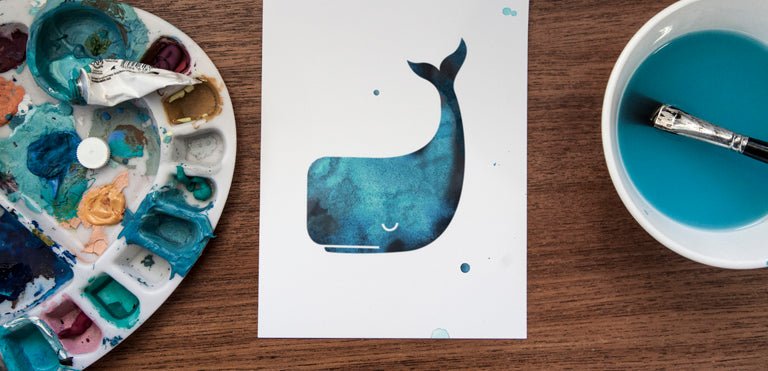When a blue whale is underwater, its skin seems to merge with the sea it lives in. Only the rings of light dancing over its back allow us to see an animal of impossible proportions. As soon as the whale begins to turn itself towards the seafloor and flicks its tail up, the rest of its body will vanish into the blue. It will be a creature between two worlds, not quite here and not quite there until only the trace of its tail is left behind it like an echo. Whales are works of art.
You proved this when you sent us hundreds of artworks for our stay-at-home competition, The Whale Challenge. Whales appeared out of thread, driftwood and steel or flowed onto the page in ink, oil paint and wax. We were amazed by the response, and happy to see so many people bringing the Ocean inside while at home! Thank you to all who participated.
Check out the winning designs below:
You can see all of the submissions by going to #thewhalechallenge. Here are some more of our favourites.
Whales are often at the heart of our clothing, the emblem we embroider onto the chest of our t-shirts. We’re fascinated by them and the lives they lead at sea and our creative director, Emil Kozak has had them floating around his mind for a while.
He says, “I’ve been drawing whales for about 20 years, there’s something mystical about them. They’re peaceful giants.” From a design perspective, “they are one of those shapes that you can boil down to the absolute minimum and still make it legible. As bold and clear as a lightning bolt.”
They’re natural icons. Which is why we put Emil’s design on everything from water bottles to socks to our signature tees. As our goal is to reduce the environmental impact of fashion and protect the Oceans, the whale came to represent TWOTHIRDS and the values we stand for, our DNA.
Few creatures can impress upon us the scope of the Ocean like whales do. Though blue whales are the largest of any being that has ever lived on Earth, they feed on the tiniest specks of sea-dust: krill. Sperm whales are believed to have their own culture, marked out by distinct ways of communicating, moving and thinking. They’ve been photographed asleep in groups, drifting upright like a small forest of silver trees swaying in an underwater breeze. Meanwhile beluga whales are so talkative they’ve been nicknamed ‘Sea Canaries’.
What we really know about whales is next to nothing, which is still much more than the whalers of the early 20th century.
In 1910, the manager of the Southern Cross Whaling company announced that “while in the water a whale is of value to nobody”. He went on to helpfully point out that “you cannot make pets of them”. The idea of protecting something so enormous was laughable to him, especially as it took so many men to kill just one whale.
Whaling fleets would go on to harpoon 3 million whales, bringing 7 species to the brink of extinction. One of them, the Right whale, is still struggling to recover. It bears the scars of its name, so called because hunters claimed it was the perfect target: the “right” whale to kill. They are highly inquisitive animals that have a strange beauty about them. Huge heads, flamboyant fins, and a white patch above the eye make them entrancing to look at as they hover over the seabed.
What saved the whale was its voice. Or at least, the voice of the legendary humpback, bellowing across the Ocean like an operatic foghorn and finally picked up by hydrophones in the 1960s. The recordings were tabled at a Greenpeace summit, sparking the movement that secured an international ban on whaling. Since then, the humpback population in South Africa has made a phenomenal comeback, from just 300 in 1979 to 30,000 whales in 2019. Other success stories are emerging around the globe, with the Antarctic blue whale making a huge leap forward this year. The trend shows positive signs that when properly protected the Ocean and its species stand a chance to recover.











